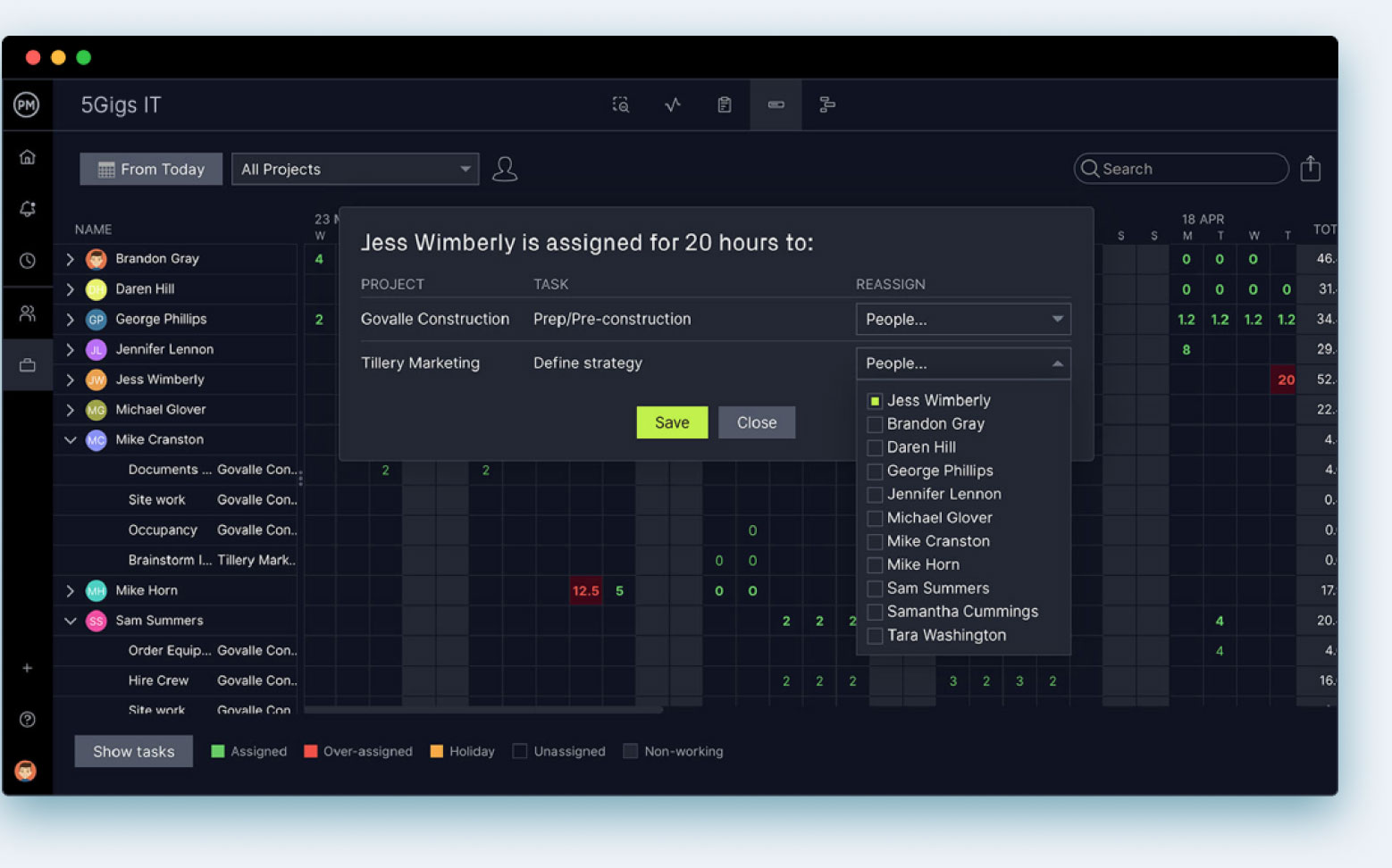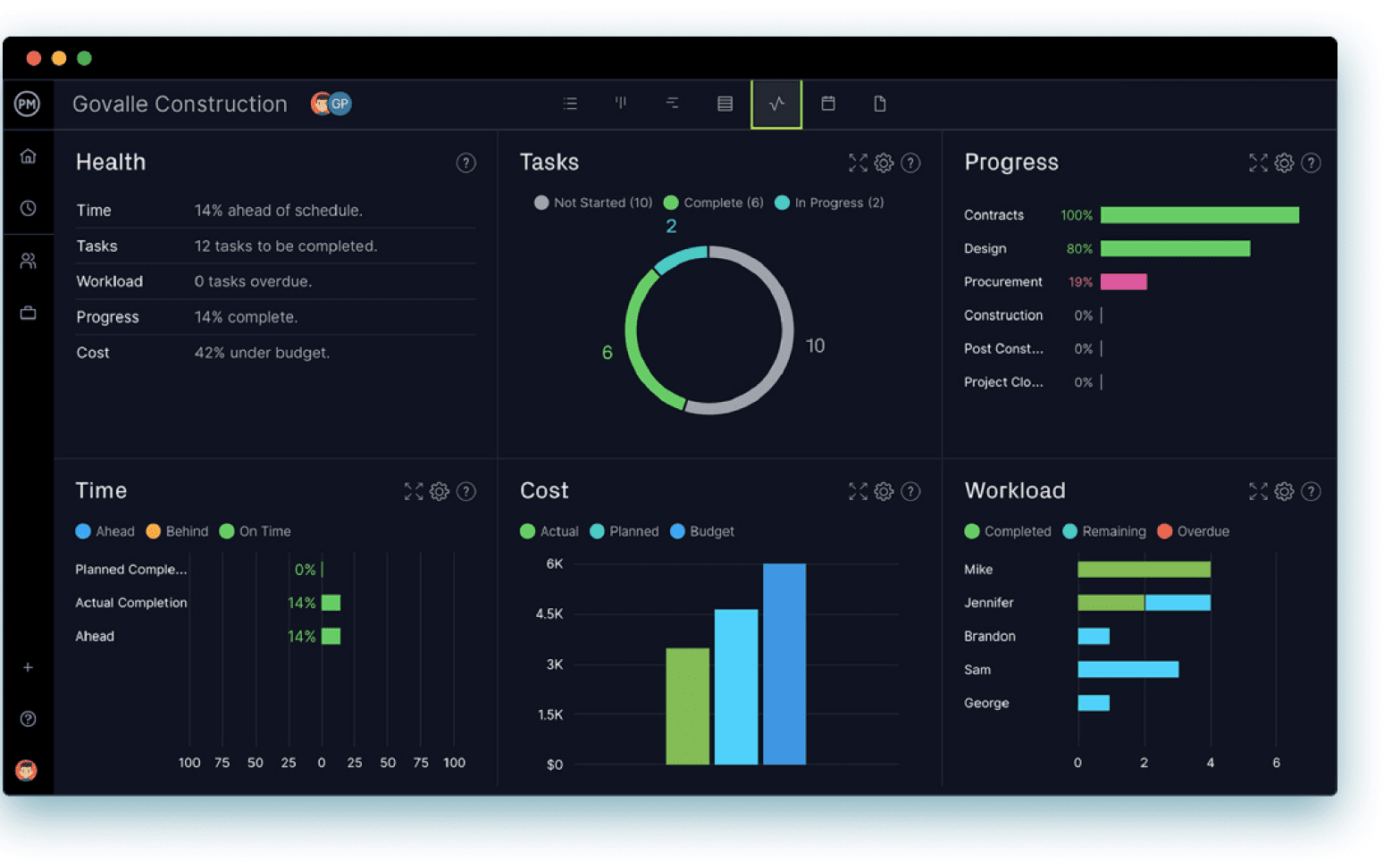Tactical planning is the practical counterpoint to strategic planning, which describes the overall direction of an organization. Tactical planning tells you how to get there. It’s about execution and, therefore, critical to achieving your strategic goals.
This concept is an important part of project portfolio management (PPM) and project management offices (PMOs). Let’s dive a bit deeper into the subject and explain how it differs from other types of planning, its benefits and more.
What Is Tactical Planning?
Tactical planning describes the action steps, strategies and projects that are deployed by the different departments of an organization, such as sales, marketing, product development and others to contribute to the accomplishment of strategic goals. It breaks down the long-term strategic plans of more than two or three years into short-term plans.
In general, tactical planning is in response to an immediate issue or situation. This can apply to a business or a project team. A strategic plan is responding to where a business wants to be in a long time, but tactical planning can also be used to submit a bid by creating a viable proposal that will win your company that business.
To achieve the strategic goals of a business, tactical plans include focused goals, steps to reach these goals and a timeline in which to achieve them. To organize and manage this process, businesses employ project management techniques and tools, such as project management software.
ProjectManager is award-winning project management software that has robust Gantt charts that help plan the tactical steps on a visual timeline. Our Gantt charts organize tasks, set milestones and link all four types of task dependencies to avoid costly delays. You can also filter for the critical path to identify essential tasks and then set a baseline to track project variance in real time. Get started with ProjectManager today for free.
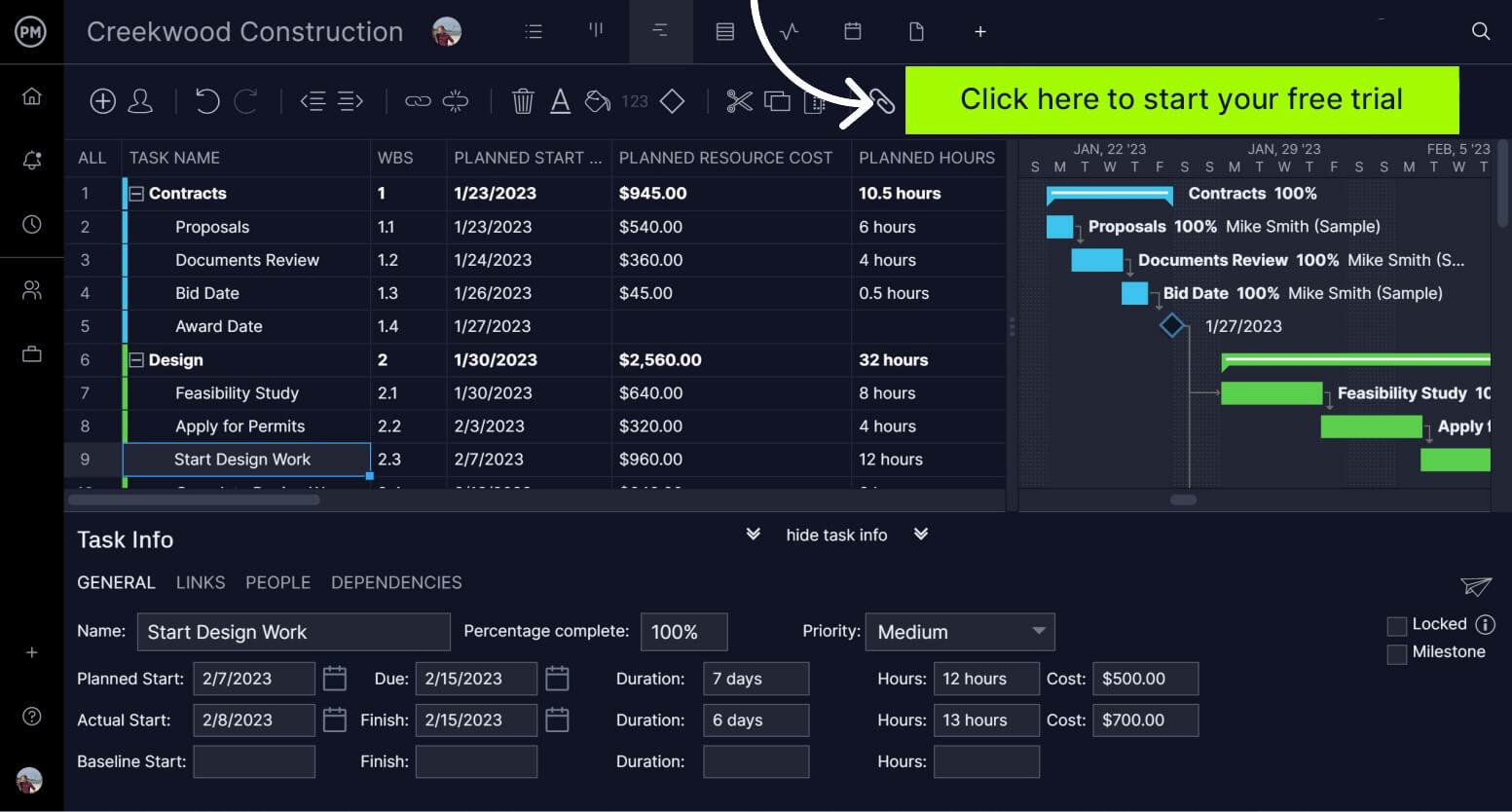
Tactical planning is one of three types of planning employed by businesses. The other two are strategic planning and operational planning, which we’ll get to in a moment.
Tactical Planning vs. Strategic Planning
Tactical planning and strategic planning are two different levels in the organizational planning of an organization. Strategic plans are high-level view goals of an organization, drafted by company owners, boards of directors and the top-level management team.
Tactical planning isn’t as long-term as strategic planning. It outlines the short-term steps that need to take place to achieve the strategic goals of the strategic plan. Tactical planning is specific, short term with clear deliverables, while strategic planning identifies broader decisions, is long term and has clear goals.
Tactical Planning vs. Operational Planning
Tactical plans can be used by departments within a business to develop and measure their functionality, but it’s different from operational planning. Operational planning is done by the lower layer of management.
Operational planning directs the everyday operations of the business departments. This goes to the most specific guidelines for business processes and daily activities of employees. So if we’re talking about a manufacturing plant, it would include the different standard operating procedures for production workers.
Benefits of Tactical Planning
The longest trip starts with the first step. This applies to how strategic goals benefit from tactical planning. But there are more benefits to tactical planning, a few of which we define below.
Connects All Levels of Management in an Organization
There are three levels to any organization. The top is the board of directors, chief executive or managing director. This is the administrative or managerial level. Then there are department managers, who are the middle level, who execute the plans from the top. After that, there’s the lower level or supervisory/operational level of management. These are supervisors, foremen, etc., who assign and manage the work of the teams. Tactical planning is the string that ties all these levels together and ensures that they’re working collaboratively.
Breaks Down Long-term Strategic Goals Into Actionable, Short-term Projects
As noted, strategic goals are long-term goals that a business wants to accomplish. Once defined, however, they need to be broken down into smaller projects or tasks that, step-by-step, will let the business reach that future target. Tactical planning takes the aspirational goals of the business and makes a practical roadmap that gets the business from where it is to where it wants to be.
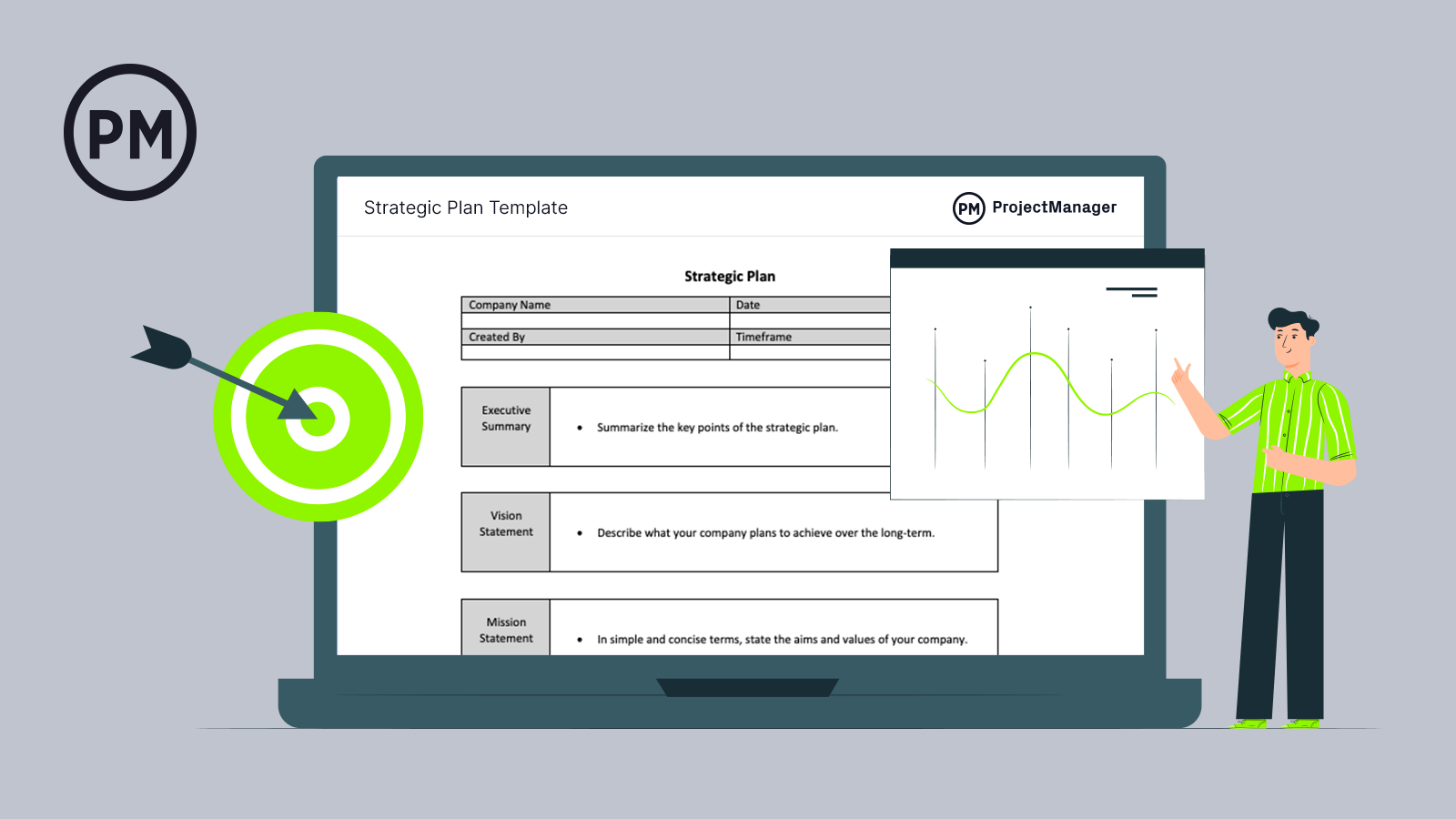
Get your free
Strategic Plan Template
Use this free Strategic Plan Template for Word to manage your projects better.
Helps Decision Makers Allocate Organizational Resources Strategically
Organizations have limited resources and each department within the organization is likely competing for those resources. Strategic and tactical planning makes it easier to decide what money should be spent on marketing, production and sales as well as other resources. Resources should be spent on the areas that contribute the most to the completion of strategic goals. That’s the criteria to prioritize them when making tactical plans.
What Is a Tactical Plan?
Now that we know what tactical planning is and why it’s beneficial, it’s time to look at the elements that make up a tactical plan. While creating a tactical plan varies from one business to the next depending on their goals, any successful one will have these key elements.
SMART Tactical Goals
Before you can plan to achieve your goals you have to have them. As the top-level management starts to think about what their long-term goals are, they should make sure they’re SMART. That’s an acronym for specific, measurable, achievable, realistic and time-bound.
Timeline
Next, you need to establish a timeline. That is, create a deadline and work backward to make a timeline in which you’ll be able to plot the tasks or steps that will get you there. This will improve your chances of reaching that end goal.
Action Steps & Projects
Those tasks are also called action steps, which take you from where you are to where you want to be by your deadline. However, bigger strategic goals and bigger organizations not only require action steps but actual projects, which are more involved. You’ll have to think about risk management, resource management, task management, etc.
Related: 8 Free Risk Management Templates for Excel
Deliverables
Deliverables describe the quantifiable goods or services that are provided throughout and after a project. You’ll want to identify these deliverables, which can be done by using a work breakdown structure. Once you have your deliverables identified, you can also identify the tasks needed to get them.
Resources
Resources are anything you’ll need to execute your tactical plan, such as materials, workforce, equipment, finance, outsourcing products and more. Managers need to identify the resources they’ll need and use the timeline to schedule those resources when they’re needed.
Key Performance Indicators (KPIs)
Once you execute your tactical plan you’ll need a ruler by which to measure its success or lack thereof, which is what KPIs are. Some KPIs are revenue, new customers, etc.
Tactical Planning Example
Let’s imagine a large appliance manufacturing company that has drawn the following strategic goals for the next two to five years. In this example, we’ll illustrate how those high-level views of strategic goals can be translated into more specific tactical plan goals and action steps.
Strategic Goals
- Increase our net revenue by 20 percent and profit margin by 10 percent
- Cut manufacturing costs by 15 percent
- Improve our customer satisfaction level by 25 percent
Tactical Plan Action Steps per Department
Here are the action steps for key departments of this company. All of these activities work together cohesively to achieve the strategic goals outlined above.
Production & Procurement
- Find suppliers that offer raw materials and components at a lower price
- Outsource and/or offshore a portion of the production process overseas to reduce production costs and increase the profit margin
- Use the excess production capacity to create new products to open new markets and support the objective of increasing revenue
- Optimize the production line to increase its resource capacity
- Purchase machinery to automate the production process and cut down labor costs
Marketing & Sales
- Find new market opportunities for new products through market research tactics
- Create a website to attract customers online
- Partner with online vendors to open new distribution channels
- Create a mobile app that customers can use to learn more about our product and contact our support team
Customer Service
- Open physical locations where users can bring or send their products for maintenance
- Improve the responsiveness of the customer service department by hiring more customer service representatives
- Use the website as a new way to respond to customers by creating a chatbot that answers the most commonly asked questions and directs customers to human customer service representatives
Product development
- Develop products that target new niches as recommended by the market research findings
- Develop new models that are cheaper to produce but retain most of the positive attributes of the current products
- Creating more energy-efficient models which has been known to be a recurring issue for existing customers
To execute each of these tactical action steps, the tactical-level managers will need to define a timeline, estimate the resources that will be required and establish key performance indicators and the tools that will be used to track them.
Strategic Plan Template
As discussed above, whenever you create a tactical plan for a business department you must make sure that it aligns with the larger strategic plan of your organization. This free strategic plan template for Word is a great tool for gathering the key elements that will help you define the overall direction of your business in the future, such as its operations plan, marketing plan and business objectives.
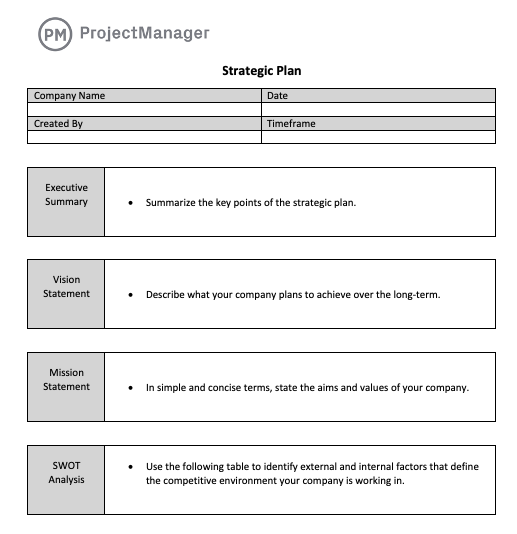
How ProjectManager Helps You Track Your Tactical Plan
Project management software can help you with tactical planning, executing those plans and then tracking them. ProjectManager is award-winning project management software that can plan, manage and track your tactical plan in real time. Not only does our software have powerful Gantt charts, but multiple project views, such as kanban boards, task lists, sheet and calendar views. That means teams can collaborate across departments in the same tool with the live data to keep them on the same page.
Allocate Resources and Track Resource Utilization
Being able to plan, allocate and track your resources is vital if you want to deliver on your strategic goals. Our software lets you set the availability of your team, including PTO and global vacations, which makes assigning them to tasks easier. You can track how much work they’re doing and labor costs on our secure timesheets. Then go over to the workload chart to see if anyone is overallocated. If they are, balance the team’s workload from the chart to keep them productive and working at capacity.

Track Costs With Real Time Dashboards
Whenever you need a high-level overview of your project, toggle over to our real-time dashboard. It automatically collects live data and displays it in easy-to-read graphs and charts that show KPIs, such as time, cost, workload and more. There’s no time-consuming setup required as in lightweight alternative products. It’s a status report whenever you want one. If you need a status report, portfolio report or reports on workload, timesheets and more, visit our reporting features. You can filter all reports and easily share them to keep stakeholders updated.
 Related Organizational Planning Content
Related Organizational Planning Content
If you want to read more about business strategy and planning projects to achieve those long-term goals, we’ve got plenty. Our website is a destination for all things project management and related topics, with weekly blogs, guides, tutorial videos and free templates. Here’s a sampling of some of the strategic-related content you’ll find on our site.
- Strategic Planning in Business
- Strategic Project Management: Planning Strategic Projects
- Strategic Plan Template for Word (Free Download)
- Project Alignment: Aligning Your Project to Business Strategy
- Project Prioritization: How to Prioritize Projects & Strategy
ProjectManager is online project management software that connects teams whether they’re in the office, out in the field or anywhere in between. You can share files, comment at the task level and stay updated with email notifications and in-app alerts. Get features to manage risk, resources and tasks to keep your tactical plans running smoothly. Join teams at Avis, Nestle and Siemens who use our software to deliver successful projects. Get started with ProjectManager today for free.

